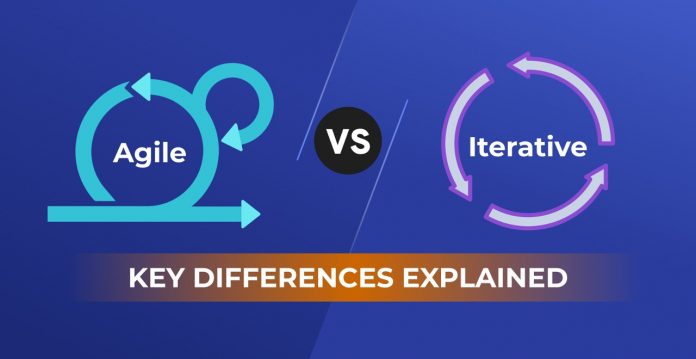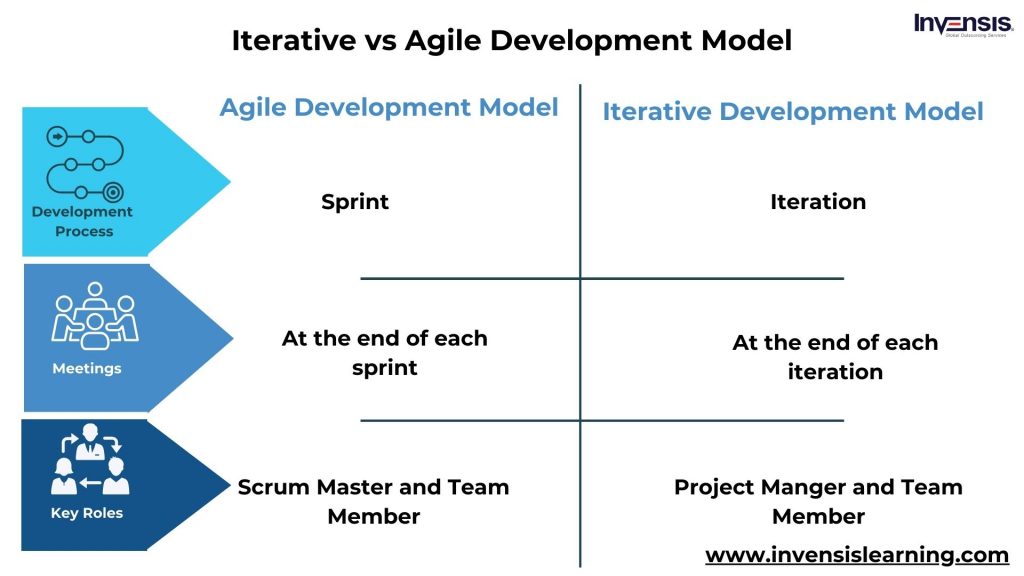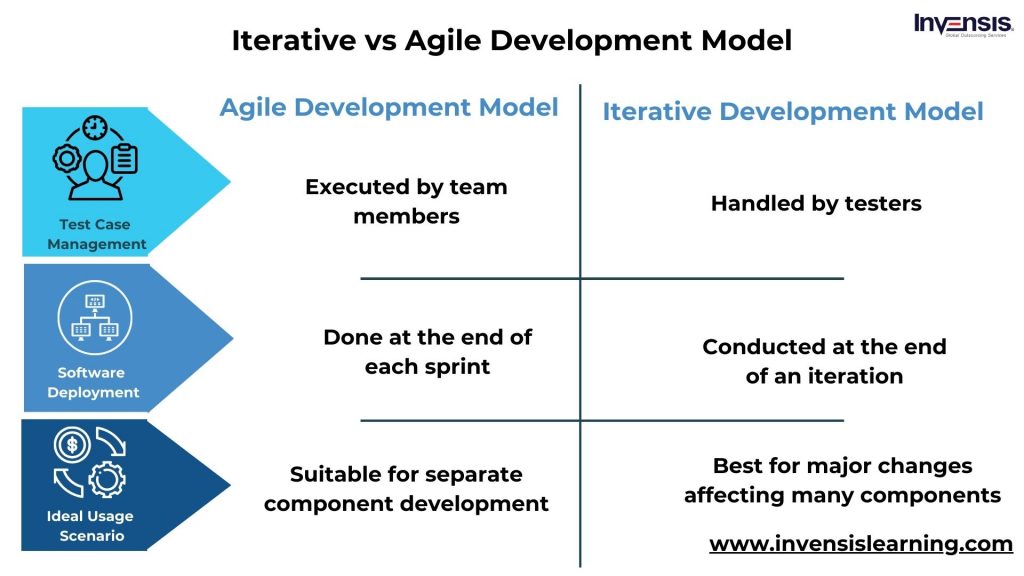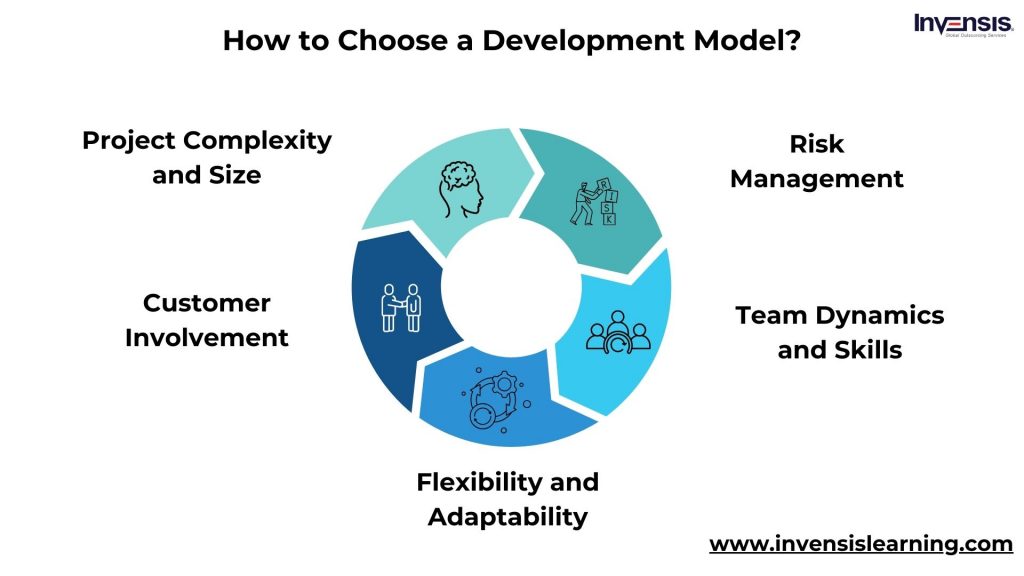
Selecting the appropriate development model can impact the success of your project. Agile and Iterative methodologies often surface in industry discussions, but grasping their distinct differences remains challenging for many.
This blog serves as your comprehensive guide, demystifying these approaches to empower you with a deeper understanding and proficiency.
If you’re a seasoned project manager, a curious developer, or simply exploring new methodologies, join us as we dissect, compare, and contrast Agile and Iterative methodologies, providing you with the knowledge to make empowered decisions in your professional journey.
Table of Contents:
- What is the Agile Development Model?
- What is the Iterative Development Model?
- Agile vs Iterative Development Models
- How to Choose a Development Model?
- Which is Better?
- Conclusion
What is the Agile Development Model?
Agile methodology, emerging as an innovative alternative to the traditional waterfall model in software development, was conceptualized in 2001 by forward-thinking software developers. This development model revolutionizes the development process by breaking the product into smaller, manageable builds.
Each build undergoes a meticulous design, coding, and testing cycle punctuated by collaborative meetings to ensure quality and alignment with objectives. This iterative process continues, with each build adding to the product, refining and adapting to new requirements.
A key feature of Agile is its use of ‘Sprints‘ — set periods dedicated to completing each build, fostering a dynamic and responsive development environment. Agile’s flexibility and emphasis on continuous improvement and team collaboration make it a standout choice in the fast-paced world of software development.
Advantages of the Agile Model
The agile development model stands out in software development for its dynamic and adaptive approach. This method is designed to meet the evolving demands of projects and clients, ensuring that the final product is high-quality and relevant.
Here are the key advantages of implementing the Agile development model:
- Enhanced Flexibility and Adaptability: The agile development model easily accommodates changes, even late in development. This flexibility is crucial where the client needs and market trends can shift rapidly.
- Increased Customer Satisfaction: With its iterative nature, Agile provides frequent updates and prototypes to clients, ensuring their continuous engagement and feedback. This often leads to products more closely aligned with client expectations.
- Improved Quality: Regular testing and reviews at each iteration mean issues are identified and resolved quickly, leading to a higher final product quality.
- Better Risk Management: Agile model’s incremental approach allows for early detection and mitigation of risks, reducing the likelihood of project failure.
- Enhanced Team Collaboration: Agile promotes a collaborative work environment where team members and stakeholders communicate regularly, fostering a deeper understanding and better problem-solving.
- Higher Project Control: Regular meetings and evaluations in Agile provide a clear view of project progress and obstacles, offering greater control and predictability.
Agile’s strengths lie in its ability to blend adaptability with discipline, ensuring that software development is a responsive, collaborative, and quality-driven process.
Disadvantages of the Agile Development Model
While Agile methodology offers numerous advantages, it’s important to recognize its limitations and challenges. Understanding these drawbacks is essential for teams to anticipate and mitigate potential issues.
Here are the key disadvantages associated with the Agile model:
- Less Predictability: Due to its flexible and adaptive nature, Agile can sometimes lead to less predictability in project timelines and budgeting. This can be challenging for long-term planning and resource allocation.
- Requires High Customer Involvement: The agile model’s success relies on continuous client or stakeholder engagement. This high involvement may only be feasible for some clients, potentially affecting the project’s direction and success.
- Increased Time and Effort: Agile’s iterative process, with frequent reviews and meetings, can be time-consuming and may require more team effort than traditional methods.
- Not Suitable for All Projects: The agile development model suits projects with uncertain or evolving requirements. Traditional methodologies might be more effective for projects with a well-defined scope and predictable outcomes.
- Potential for Scope Creep: Without strict control, the flexibility of Agile can lead to scope creep, where continuous changes and additions extend beyond the original project boundaries.
- Dependence on Team Dynamics: Agile’s success depends on the team’s collaboration and communication skills. Teams lacking in these areas might need help to implement Agile practices effectively.
Understanding these disadvantages is crucial for teams considering Agile, as it helps create strategies to address these challenges and effectively leverage Agile’s strengths.
What is the Iterative Development Model?
The Iterative Development Model is a systematic approach to software development characterized by repeated cycles (iterations) of development and refinement. Unlike traditional linear models, it breaks down the software development process into smaller, more manageable segments, allowing developers to focus on a subset of functionality during each iteration.
In this model, the development cycle begins with a simple implementation of a small set of software requirements and iteratively enhances the evolving versions until the full system is implemented. The design can be modified at each iteration, and new functional capabilities can be added.
Advantages of the Iterative Development Model
The Iterative development model offers a dynamic approach to software creation, allowing teams to evolve and refine their products through repeated cycles. This model is particularly effective in managing complex projects and adapting to changing requirements.
Below are the key advantages of adopting the Iterative Development Model:
- Early Detection of Issues: Breaking the project into smaller segments makes it easier to identify and fix defects early in the development process, reducing the risk of major problems at later stages.
- Flexibility in Changes: The iterative nature allows for modifications and adaptations as the project progresses. This flexibility is crucial for projects where requirements are expected to evolve or need to be fully defined.
- Improved Risk Management: Risks are identified and addressed in each iteration, making managing and mitigating them easier.
- Customer Feedback and Satisfaction: Regular reviews and iterations mean stakeholders can provide feedback throughout development. This continual input ensures the final product aligns more closely with customer expectations.
- Efficient Use of Resources: Since the work is divided into manageable chunks, resources can be allocated more efficiently, and workload can be better balanced throughout the project lifecycle.
- Early and Incremental Delivery: The iterative model allows for the early delivery of certain features, providing a functional product from an early stage and continuously improving it.
The Iterative Development Model’s emphasis on gradual improvement and responsiveness makes it a robust choice for projects requiring adaptability and constant evolution in line with user feedback and changing market demands.
Disadvantages of the Iterative Development Model
While the Iterative Development Model is highly effective in many scenarios, it also has drawbacks. Understanding these limitations is crucial for teams to navigate potential challenges strategically.
Here are the significant disadvantages associated with the Iterative Development Model:
- Resource Intensity: Each iteration requires a full cycle of planning, development, and testing, which can be resource-intensive in terms of time, workforce, and costs.
- Complex Project Management: Managing the iterative process, especially for large projects, can become complex, requiring meticulous coordination and tracking across different stages and iterations.
- Risk of Scope Creep: The flexibility to adapt and change with each iteration can lead to scope creep, where the project’s requirements continuously expand or change, potentially leading to delays and inflated costs.
- Potential for Inefficient Utilization of Resources: With careful planning, resources may be well-spent on developing features later altered or discarded in subsequent iterations.
- Dependency on Clear Initial Requirements: Despite its flexibility, the Iterative Model still relies on a clear understanding of the initial project requirements to guide the direction of the iterations.
- Need for Constant Stakeholder Involvement: Continuous input from stakeholders is required, which can be challenging if they are not consistently available or committed to the project.
Understanding these challenges is essential for any team or organization considering the Iterative Development Model, as it allows them to effectively prepare and implement strategies to mitigate these disadvantages.
Agile vs Iterative Development Models
Understanding the differences between the Iterative and Agile Development Models is crucial for software professionals. Both models are popular in software development but serve different purposes and have unique characteristics.
Below is a comparison that highlights the key differences between these two methodologies:
- Approach to Development: Agile focuses on continuous collaboration and rapid response to change, while the Iterative Model takes a more gradual approach, building up the final product over multiple iterations
- Process and Terminology: Agile uses ‘Sprints’ for its development cycles, emphasizing rapid delivery, whereas the Iterative Model uses ‘Iterations’ for gradual improvement
- Roles and Responsibilities: In Agile, the Scrum Master and Team Members play pivotal roles, strongly focusing on team collaboration. The Iterative Model typically involves a Project Manager and Team Members with more traditional roles
- Testing and Quality Assurance: Agile integrates testing into the development process, often conducted by the team members themselves, while the Iterative Model may have dedicated testers for this task
- Project Outcome and Adaptability: Agile is designed to adapt quickly to changes, making it suitable for projects with frequent updates. The Iterative Model, while adaptable, is more structured and better suited for projects with major, less frequent changes
| Aspect | Agile Model | Iterative Model |
| Basic Concept | Enhances specifications and solutions through continuous collaboration | Begins with small elements, evolving iteratively to the final solution |
| Development Process | Known as a Sprint | Referred to as an Iteration |
| Post-Completion Meetings | A meeting is carried out after each sprint | A meeting is conducted at the end of each iteration |
| Impact of Previous Cycles | The preceding sprint influences the subsequent sprint | Each iteration affects the next |
| Review Opportunities | Products can be reviewed during a Sprint | Reviews are based on the iteration baseline. |
| Key Roles | Scrum Master and Team Member | Project Manager and Team Member |
| Role Responsibilities | Scrum Master facilitates; team members estimate | Project Manager estimates and oversees iteration completion |
| Test Case Management | Executed by team members | Handled by testers |
| Software Deployment | Done at the end of each sprint | Conducted at the end of an iteration |
| Outcome of Unsuccessful Cycles | Considered a failure within the iteration if no valued work product is obtained | Always produces a work product of some value after each iteration |
| Ideal Usage Scenario | Suitable for separate component development or for quick, frequent changes | Best for major changes affecting numerous components |
By understanding these differences, teams can decide which model best suits their project needs, ensuring more efficient and effective software development processes.
How to Choose a Development Model?
When selecting the most suitable development model for a software project, the choice between Agile and Iterative models can be complex. Both methodologies have their strengths and are better suited to different types of projects.
To determine which is the better choice, consider the following factors:
Project Complexity and Size
- Agile: Ideal for projects where requirements are expected to change frequently or need to be fully defined. Agile works well with small to medium-sized teams and projects.
- Iterative: More suitable for large-scale projects with complex requirements requiring a structured but flexible approach.
Customer Involvement
- Agile: Requires high levels of customer involvement for regular feedback and iterations. Choose Agile if your stakeholders are willing and able to engage closely throughout the development process.
- Iterative: Less reliant on constant stakeholder feedback, making it a better choice if customer availability is limited.
Flexibility and Adaptability
- Agile: Offers high flexibility for accommodating changes at any point in the development process. Opt for Agile if your project operates in a dynamic environment with evolving requirements.
- Iterative: Provides a structured yet adaptable framework. Knowing the broad project requirements is beneficial, but expect some change.
Time to Market
- Agile: Agile’s incremental delivery approach can lead to faster product releases and delivery of individual features.
- Iterative: It may take longer to deliver a final product as it focuses on building and refining the system over multiple iterations.
Team Dynamics and Skills
- Agile: Relies on highly collaborative teams with strong communication skills. Choose Agile if your team is adaptable, self-organizing, and capable of working in fast-paced environments.
- Iterative: Suitable for teams accustomed to traditional development processes but looking for more flexibility. It’s less demanding in terms of constant team collaboration compared to Agile.
Risk Management
- Agile: Excellent for projects where risks must be continuously assessed and managed.
- Iterative: Also good for risk management but in a more structured manner.
Which is Better?
There is no one-size-fits-all answer.
The better choice depends on your project’s specific needs, team dynamics, customer involvement, and adaptability requirements. Agile is often favored for its flexibility and customer-centric approach, making it ideal for rapidly changing environments. In contrast, the iterative model is preferred for its structured adaptability, suitable for larger projects with defined but evolving requirements.
Ultimately, the decision should be based on thoroughly assessing your project’s characteristics, team capabilities, and stakeholder expectations. Understanding the nuances of each model and aligning them with your project goals will guide you to the right choice.
Conclusion
Agile and Iterative models are both pivotal in software development, each with its distinct approach and advantages. Agile, often considered a specialized iteration of the Iterative model, focuses on delivering incremental value.
On the other hand, the iterative model is characterized by its structured approach to gradually evolve the project through repeated cycles, which is suitable for larger, complex projects with known refining requirements.
Understanding these methodologies is crucial for choosing the right approach for your project. Consider exploring our Agile Certification courses to delve deeper into Agile methodologies and effectively apply them in your professional landscape. These courses equip you with practical knowledge and skills, enhancing your proficiency in Agile practices.

















